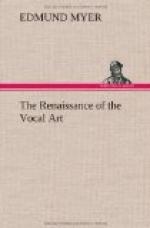When the singer lifts and expands in a free, flexible manner the body fills with breath. One would have to consciously resist this to prevent the filling of the lungs. The breath taken in this way means expansion, inflation, ease, freedom. There is no desire to expel the breath got in this way; it is controlled easily and naturally from position—the level of the tone. When the breath is thus got through right position and action, we secure automatic form and adjustment; and correct adjustment means approximation of the breath bands, inflation of the cavities—in fact, all true conditions of tone. Nature has placed within the organ of sound the principle of a double valve,—one of the strongest forces known in mechanics,—for the control of the breath during the act of singing. This is what we mean by automatic breath-control—using the forces which Nature has given us for that purpose, using them in the proper manner.
If the reader is familiar with my last two works, “Vocal Reinforcement” and “Position and Action in Singing,” he will have learned through them that we have not direct, correct control of the form and adjustment of the parts which secure the true conditions of tone and automatic breath-control. These conditions, as we have learned, are secured through the flexible movements which are the ground-work of our system. Therefore we say, Trust the movements. If you have confidence in them, they will always serve you. If you doubt them, they are doubtful; for the least doubt on the part of the singer means more or less contraction and restraint; hence they fail to produce the true conditions.
This automatic breathing, the result of the movements described, does not show effort or action half so much as the old-fashioned, conscious muscular breath. Breathing in this way means the use of all the forces which Nature has given us. Breathing in this way is Nature’s demand, and the reward is Nature’s help.
The devices we use to develop automatic breathing and automatic breath-control are the simplest possible exercises, studied and developed through the movements, as before described. In this way through right action we expand to breathe, or rather we breathe through flexible expansion, and we control by position, by the true level of the tone. In this way, as we have found, all true conditions are secured and maintained.
We will take for our first study a single tone about the middle of the voice. Exercise three in Article One of this second part of the book will suggest the idea.
Sing a tone about the middle of the voice with the syllable ah. Lift, expand, and let go, by the use of the hands and the body, as before suggested. The lifting and expanding in a free, flexible manner will give you all the breath that is needed; and the position, the level of the tone, will hold or control the breath if you have confidence. Remember that automatic breathing depends upon first action, the movement from repose to the level of the tone. If the action is as described, sufficient breath will be the result. If the position, the level of the tone, is maintained without contraction, absolute automatic breath-control will be the result so sure as the sun shines.




